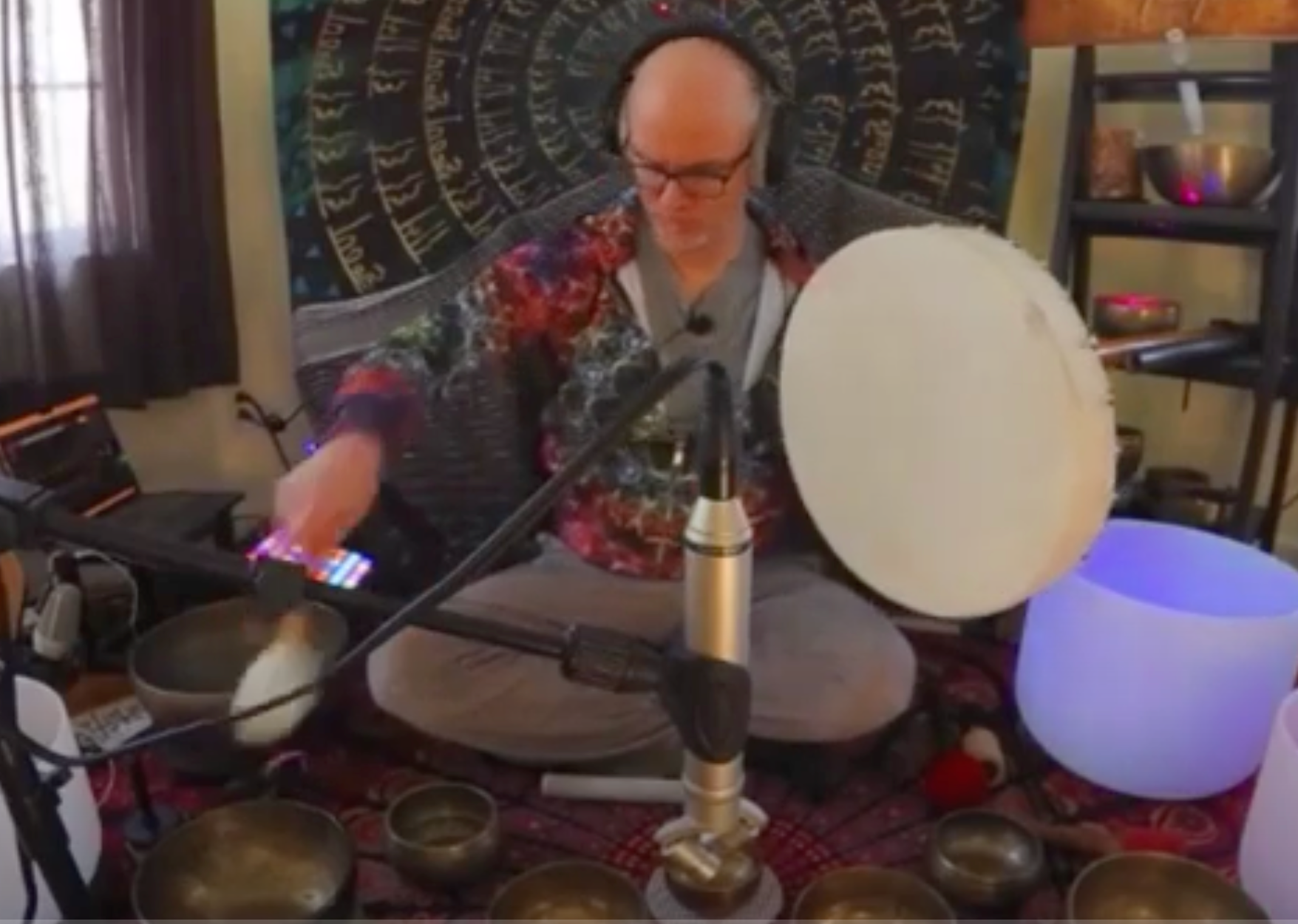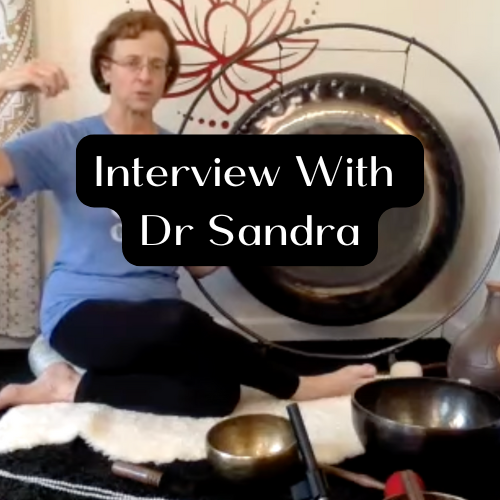The mathematical is the gateway to what we refer to as "musical," and the musical creates what we experience as mystical.
The organizing principles of harmony, which we are using here as simply "sounds good," is based on mathematical relationships between frequencies.
What sounds good to you -- is the tip of the iceberg.
To create profound changes in our bodies and brains through the layering of vocals, chants, mantras, and Tibetan singing bowls, we can combine these elements to harness their unique vibrational and psycho-acoustic effects.
Here’s how each component contributes and how to specifically layer them for optimal impact, as it relates to two tools -- our voice, and our singing bowls.
1. Tibetan Singing Bowls: Creating a Base of Vibrational Resonance
Tibetan singing bowls produce rich, sustained tones that vibrate at frequencies deeply aligned with our brainwaves and energetic body.
Their resonance can entrain brainwaves (match the listeners brainwaves to the same frequencies they are hearing), inducing states of deep relaxation, meditation, or heightened awareness.
They also create a direct vibrational impact on the body, particularly when placed near or on specific chakras or energy points -- can be referred to as vibrational massage.
This vibrational energy helps break up blockages in the body's energy field, promoting emotional release and physical healing.
- Lower Bowls (C, D) produce grounding vibrations that resonate with lower chakras and slower brainwaves (theta and delta). These bowls help calm the nervous system and bring you into deeper states of relaxation and sleep.
- Higher Bowls (F, G, A) resonate with higher chakras and promote a sense of spiritual connection and emotional elevation. These tones can encourage creativity, intuition, and transcendence.
2. Vocals and Chants: Amplifying Emotional and Spiritual Healing
Vocalizations—whether through toning, chanting, or singing—carry the vibrational power of human emotion. Our voices can create frequencies that directly impact both our mental and physical states, especially when aligned with specific frequencies. Chanting mantras or repeating sacred syllables helps calm the mind and activate specific energetic points in the body (for both the listener, and the chanter)
-
Toning: Sustained vocal sounds, such as humming or vowel tones, are a form of vibrational medicine that activates resonance in the body’s tissues. Humming specifically can create gentle vibrations in the sinuses and skull, positively affecting the vagus nerve, which calms the autonomic nervous system.
-
Chanting: Sacred chants, like "Om" or specific mantras, can be combined with the singing bowl tones to create a vibrational blend. For example, the mantra "Om" resonates with the crown chakra and can be layered with higher singing bowls to open spiritual awareness and deepen meditation.
-
Bija Mantras: These are seed sounds associated with each chakra, such as "Lam" for the root or "Om" for the crown. When vocalized with intention and rhythm, these sounds amplify the activation of specific energy centers, particularly when aligned with bowls attuned to those same chakras.
3. Mantras and Intent: Rewiring Thought Patterns
Mantras are powerful, repetitive phrases or syllables that reprogram the subconscious mind by creating neural pathways that align with the desired state of being—whether it's peace, abundance, or healing. The repetition of mantras influences brainwave patterns, pushing the mind toward more coherent, focused states of consciousness.
- Synchronizing with Bowls: When repeating a mantra in rhythm with the sound of the bowls, you create a synergistic effect, where both the sound and the repetition of the words help rewire thought patterns. For instance, a bowl played in a steady rhythm while chanting “So Hum” can help stabilize wandering thoughts and bring focus and clarity to meditation.
4. Combining Rhythms and Frequencies: Creating Synchronization
To achieve optimal brainwave entrainment and physiological changes, you can layer rhythms and harmonics created by bowls with specific vocal tones or mantras. Here's how this can be done:
-
Step 1: Start with Tibetan Singing Bowls for Grounding: Begin by playing one or two bowls that resonate with lower chakras (like C or D) to establish grounding frequencies. These help slow the brain down into theta waves, the state of deep meditation and introspection.
-
Step 2: Add Chanting for Breath and Heart Rate Synchronization: Once the foundational bowl tones are established, introduce a steady chant like "Om" or a bija mantra in a slow rhythm. This chant should be in sync with the natural rhythm of your breath, helping to slow your breathing and lower your heart rate. The synergy between the chant and the bowl will help activate the parasympathetic nervous system, which reduces stress and promotes healing.
-
Step 3: Layer Higher Frequencies for Emotional Release and Spiritual Upliftment: Gradually introduce higher-pitched bowls (such as F or G) while increasing the complexity of the chant or vocal toning. Higher frequencies work on the emotional body and upper chakras, encouraging the release of stored emotions and promoting feelings of joy, love, and spiritual connection.
5. The Science Behind These Layers: Brain and Body Effects
The combination of these elements—vocal toning, mantras, and the harmonic resonance of Tibetan singing bowls—creates a feedback loop of brain and body entrainment.
-
Brainwave Synchronization: The steady pulse of the bowls and rhythm of the chants help shift brainwaves from beta (normal waking consciousness) to alpha or theta (relaxation and deep meditation). Theta brainwave states are associated with creativity, emotional healing, and enhanced intuition. This creates a space for the mind to release tension and access deeper insights.
-
Breathing and Heart Rate: Chanting, especially in slow, rhythmic patterns, naturally slows down breathing, which in turn lowers heart rate and induces a calming effect on the nervous system. Tibetan singing bowls, when played rhythmically, can sync with these physiological rhythms, further amplifying the calming effect.
-
Vagus Nerve Activation: The vagus nerve, a key player in the parasympathetic nervous system, is particularly sensitive to vibrations. The combination of singing bowls and chanting can stimulate the vagus nerve, promoting relaxation, reducing inflammation, and improving mood.
6. A Specific Example for Creating a Healing Session
Let’s say you want to create a session that promotes emotional healing and mental clarity. You could do the following:
-
Begin with Deep Toning (Low Frequencies): Start with deep-toned bowls (C and D) and have participants hum or tone along. The hum will activate vibrations in the chest, calming the body and starting the process of grounding.
-
Introduce a Simple Mantra with Mid-Tone Bowls (Heart Activation): As the body starts to relax, introduce the mantra "Om Mani Padme Hum" in sync with the rhythmic playing of mid-toned bowls (E, F). This opens the heart and connects the emotional and spiritual bodies.
-
Finish with Higher Tones and Elevated Chants: As you move into higher frequencies, allow for faster chanting, vocalizing vowel sounds like "Ah" or "Ee" with high-pitched bowls. This elevates the emotional state, encourages joy and spiritual connection, and can bring participants to a state of bliss or emotional release.
By layering Tibetan singing bowls with vocals and mantras, you create a multi-sensory, multi-dimensional healing experience that taps into the body's natural rhythms, rewires thought patterns, and entrains the brain to more harmonious, healing states.
This combination has the power to shift consciousness, promote emotional release, and induce deep physical healing....
Wondering "How Does This Actually Work" -- keep reading below for more of the scientific principles we've introduced above.
Brainwaves and Entrainment
Our brain operates in various wave frequencies, ranging from high-frequency beta waves (alertness and problem-solving) to low-frequency delta waves (deep sleep). Music, particularly through specific rhythms and frequencies, can entrain or synchronize our brainwaves to different states.
Beta waves (13-30 Hz): Active thinking, focus, and alertness. Up-tempo music can help enhance concentration and stimulate the brain.
Alpha waves (8-12 Hz): Relaxed, reflective states. Music with a slower tempo (such as classical or ambient sounds) can induce a calm, meditative state, allowing for creativity and stress relief.
Theta waves (4-8 Hz): Deep relaxation and meditative states, often accessed through repetitive rhythms or specific frequencies like binaural beats. These states are associated with deep creativity and intuitive insight.
Delta waves (1-4 Hz): Deep sleep and healing. Certain types of music can help lull the brain into these slower frequencies, promoting restful sleep and restoration.
Impact on Emotions:
Music directly impacts our emotions through several mechanisms.
Rhythm and Beat: Rhythmic patterns can influence emotional states by creating a sense of predictability or surprise. Faster rhythms can invoke excitement or even anxiety, while slower rhythms often induce calmness or introspection. Music in a major key tends to elicit feelings of happiness and energy, while music in minor keys is often associated with sadness or melancholy.
Melody and Harmony: Music's structure—how melodies rise and fall and how harmonies create tension and resolution—can directly impact how we feel. Dissonant harmonies create tension, which can make us feel uneasy or alert. Conversely, consonant harmonies promote feelings of peace and resolution.
Timbre and Instrumentation: The texture of the music, created by the specific instruments or vocal tones, plays a significant role in shaping our emotional experience. For example, the sound of a human voice or a string instrument can evoke warmth and comfort, while synthesized or mechanical sounds may evoke detachment or futuristic moods.
Physiological Responses:
Music impacts our physical bodies just as much as our minds. Here’s how:
Heart Rate: Music with a strong rhythmic pulse can entrain our heart rate. Fast-paced, up-tempo music can elevate our heart rate and make us feel more energetic or anxious, while slow, soothing music can slow down the heart rate, promoting relaxation and a sense of calm.
Breathing: The tempo and rhythm of music can influence our breathing patterns. Slow, steady beats encourage slower, deeper breathing, which activates the parasympathetic nervous system—the body’s “rest and digest” mode. Conversely, fast or erratic rhythms can make our breathing shallower and faster, engaging the fight-or-flight response.
Hormonal Response: Music has been shown to influence the release of hormones like cortisol (stress hormone) and dopamine (pleasure hormone). Uplifting music can boost dopamine levels, improving mood and creating feelings of euphoria, while calming music can lower cortisol levels, reducing stress and anxiety.
By understanding the scientific principles of brainwave entrainment, rhythmic synchronization, and emotional modulation, we can consciously use music to transform our mood, reduce stress, and tap into deeper levels of consciousness.
It’s not just about what we hear; it’s about how we feel and, ultimately, how we heal.
Want to learn how to use sound, to create transformational experiences for others?
Join us in Ohm Store's Sound School, which begins Oct 15.










